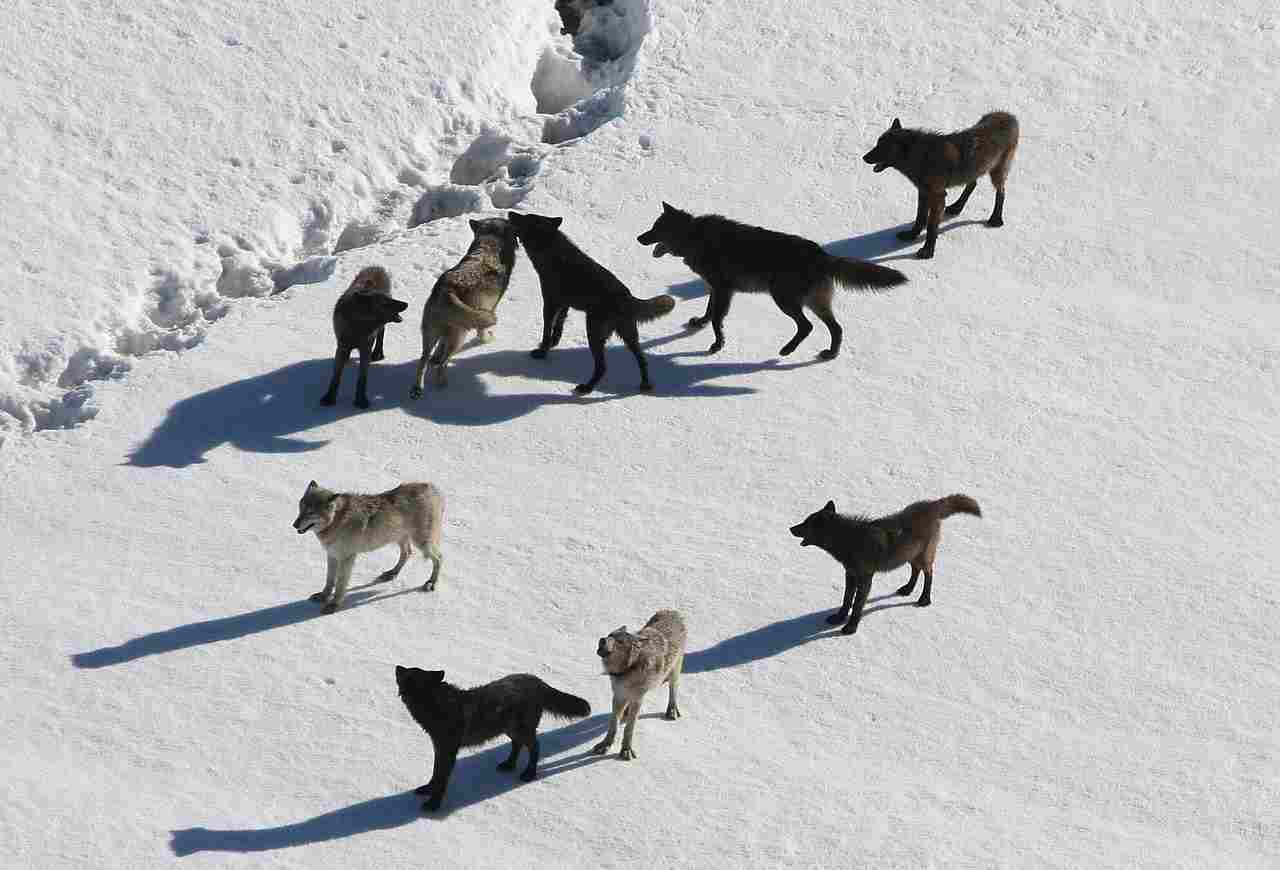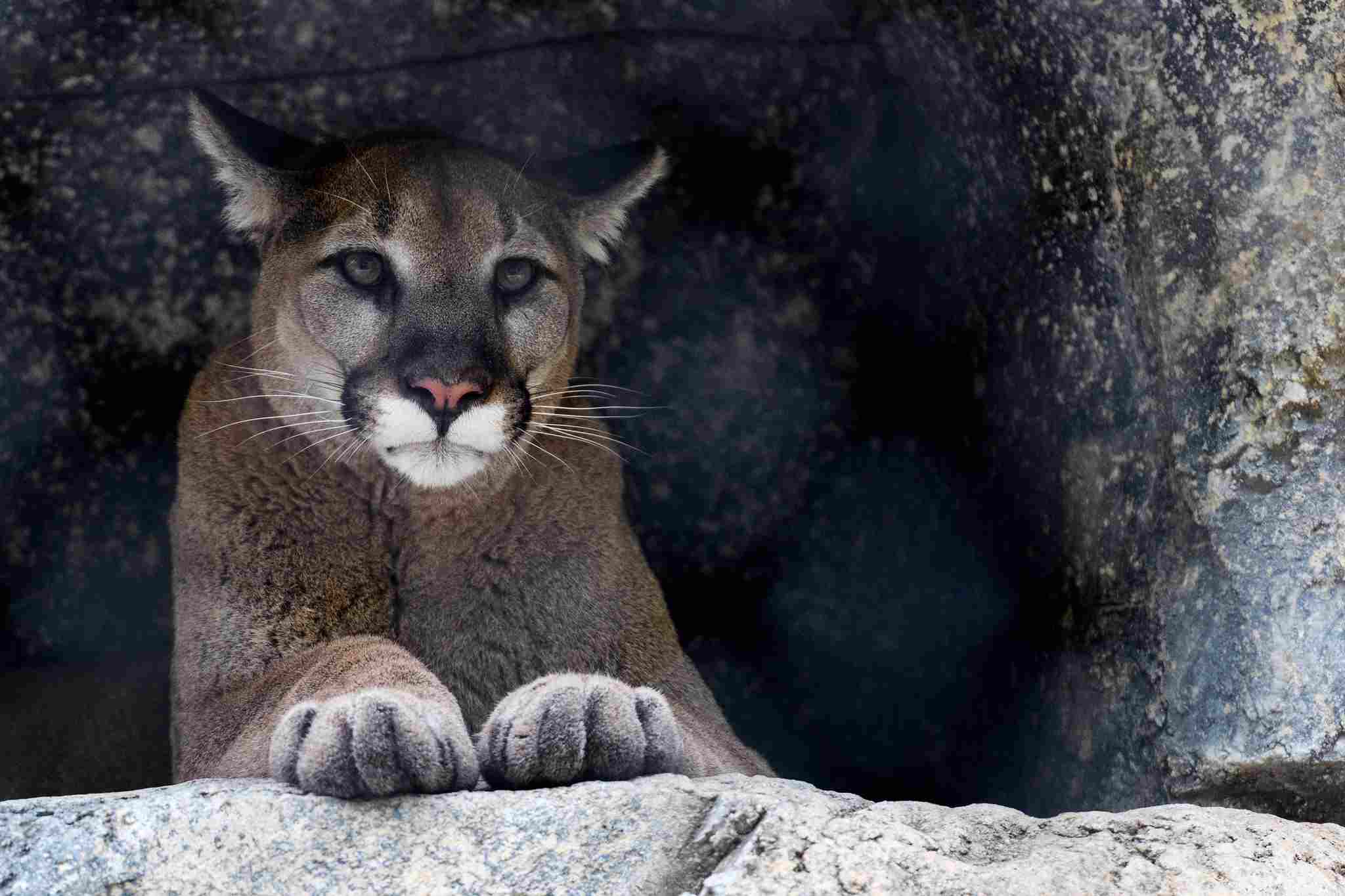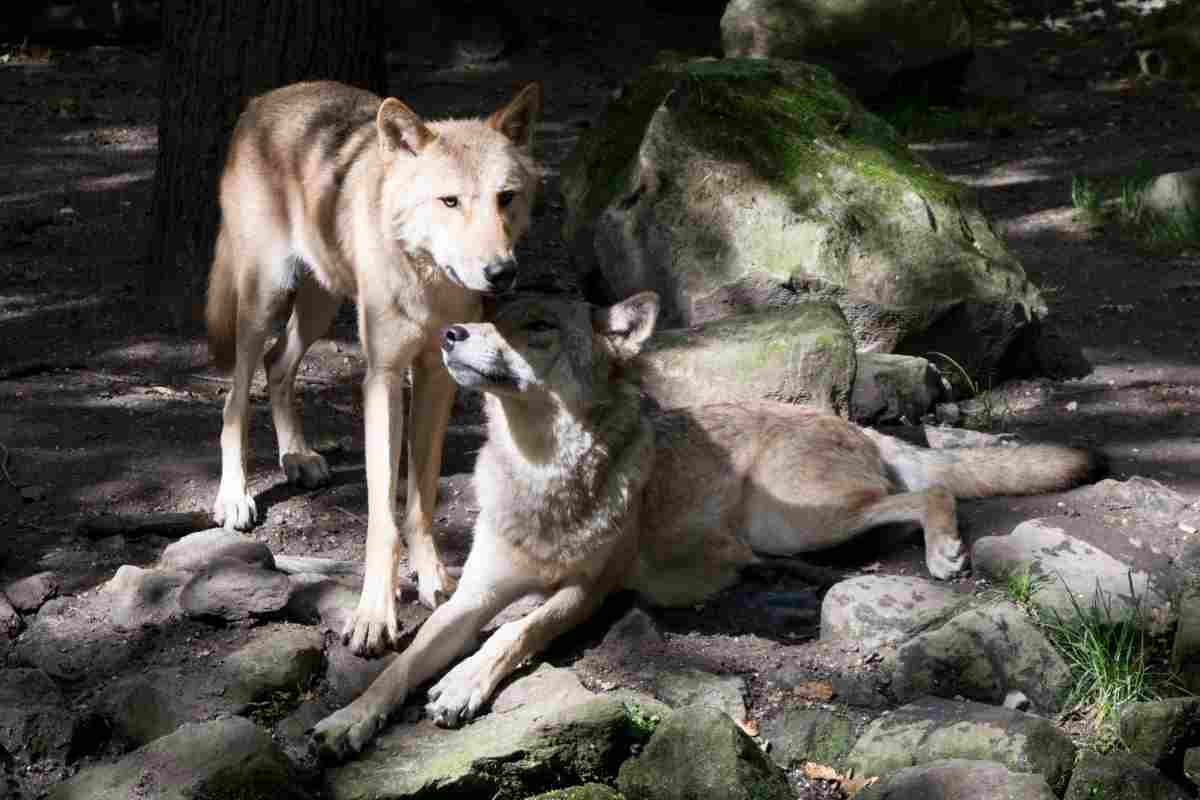Wolf Vs Mountain Lion Size, Weight, Ecological Comparison
Mountain lions and wolves engage in fierce battles, with each species having its own advantages. While a mountain lion can ambush and kill a single wolf, wolves often overpower mountain lions by using their numbers advantage.
In this article, we will explore various factors that can be used to compare these animals, such as taxonomy, appearance, size, weight, speed and agility, bite force, overall physical capacity, habitat, lifespan, behavior, reproduction, danger posed to humans, and conservation status.
Key Outcomes
*Biological Comparison
Wolf and mountain lion, also known as cougar or puma, are not biologically related. While the wolf belongs to the Canidae family, the mountain lion belongs to the Felidae family. Despite their differences, both animals are top predators in their respective ecosystems.
*Size and Weight Comparison
The size and weight of wolves and mountain lions differ significantly. Wolves are generally smaller than mountain lions, with adult males weighing between 70 and 110 pounds, while females weigh between 50 and 85 pounds. In contrast, adult male mountain lions weigh between 110 and 180 pounds, and females weigh between 80 and 130 pounds. In terms of size, wolves can reach lengths of 4.5 to 6.5 feet, excluding the tail, while mountain lions typically measure between 5 and 9 feet in length, including the tail.
Overall, mountain lions are larger, heavier, and longer than wolves.
*Physical Capability Comparison
The physical capabilities of wolves and mountain lions are often compared to determine which animal is stronger. While both animals possess impressive strength, the mountain lion is known for its superior power. In a confrontation between the two, the mountain lion’s strength and agility give it the advantage, potentially overpowering and causing the death of the wolf. This physical capability comparison highlights the contrasting abilities of these two predators.
1). Taxonomy
The taxonomy of wolves and mountain lions reveals interesting similarities and differences between these two predators. Wolves belong to the genus Canis and the species lupus, while mountain lions are classified as Puma concolor. Despite their distinct classifications, both animals are part of the larger family Felidae, which includes all feline species.
In terms of comparison, wolves and mountain lions differ in their taxonomic groups. Wolves are part of the Canidae family, which also includes domestic dogs and foxes. On the other hand, mountain lions belong to the Felidae family, which encompasses various big cats like lions, tigers, and leopards.
While wolves and mountain lions share some similarities in their taxonomic classifications, their distinct family affiliations highlight their evolutionary divergence. Wolves have evolved alongside other canids, adapting to a different set of ecological niches and prey. Mountain lions, as part of the Felidae family, have developed unique characteristics and hunting strategies that suit their solitary and stealthy nature.
2). Appearance
The appearance of wolves and mountain lions is distinct and adapted to their respective habitats and hunting strategies.
In terms of their coat, both animals have fur that serves as protection against the elements. Wolves typically have a thick double coat, with a coarse outer layer and a soft undercoat, which provides insulation in cold climates. Mountain lions, on the other hand, have a shorter and smoother coat that helps them blend into their surroundings.
Camouflage is an important aspect of their appearance. Wolves have a range of coat colors, including gray, brown, black, and white, which allows them to blend in with their environment, whether it be snowy landscapes or dense forests. Mountain lions, also known as cougars, have a tawny or reddish-brown coat that helps them blend into the rocky terrain and vegetation of their habitats.
In terms of stature and build, wolves are known for their robust and muscular bodies. They have a stocky build, with strong legs and a broad chest, which enables them to take down large prey. Mountain lions, on the other hand, have a more slender and agile physique. They have a long and flexible body, with powerful hind legs that allow them to leap and pounce on their prey with precision.
3). Size
When comparing the size of wolves and mountain lions, several factors come into play, including total body length and height at the shoulders. Mountain lions are generally larger and longer than wolves, making them an imposing presence in their respective habitats.
Mountain lions, also known as cougars, can reach impressive lengths, with adult males measuring up to 8 feet from nose to tail. In comparison, wolves typically have a total body length of around 4 to 6.5 feet. This significant difference in size gives mountain lions an advantage when it comes to hunting and taking down prey.
In terms of height at the shoulders, mountain lions also have the upper hand. Adult males can stand at around 2.5 to 3 feet tall, while wolves generally reach heights of 2 to 2.5 feet. This additional height allows mountain lions to have a better vantage point and a more commanding presence in their environment.
Overall, when it comes to size, mountain lions surpass wolves in both length and height. This larger size contributes to their ability to tackle larger prey and assert their dominance in their respective ecosystems.

4). Weight
When comparing the weight of wolves and mountain lions, it is clear that mountain lions have the advantage in terms of size and mass. Adult male mountain lions can weigh anywhere between 100 to 220 pounds, with some exceptional individuals reaching up to 250 pounds. In contrast, adult male wolves typically weigh between 70 to 110 pounds, making them significantly lighter than their feline counterparts.
The weight discrepancy between these two predators is not only due to their different body structures but also their hunting strategies. Mountain lions rely on their strength and agility to overpower their prey, often taking down larger animals such as deer or elk. Their larger size and weight provide them with the necessary power to bring down such formidable prey.
On the other hand, wolves are highly social animals that rely on teamwork and coordination to hunt. Their lighter weight allows them to be more agile and maneuverable, making it easier for them to chase down and capture smaller prey like rabbits or rodents.
On average, mountain lions outweigh wolves by a significant margin. This weight advantage plays a crucial role in determining their hunting capabilities and the types of prey they can successfully target.
5). Speed and Agility
When comparing the speed and agility of wolves and mountain lions, it becomes evident that both predators possess remarkable physical capabilities. Mountain lions are known for their incredible speed and agility, allowing them to swiftly navigate through their environment and pursue their prey. With their muscular bodies and long hind limbs, mountain lions can reach speeds of up to 50 miles per hour in short bursts, making them one of the fastest land animals.
On the other hand, wolves may not match the top speed of mountain lions, but they compensate with their exceptional endurance and agility. Wolves are capable of maintaining a steady pace for long distances, often covering up to 20 miles in a single day. Their agility enables them to navigate through various terrains, including forests, mountains, and snow-covered landscapes.
The difference in speed and agility between wolves and mountain lions can be attributed to their distinct hunting strategies. Mountain lions rely on their bursts of speed to ambush and overpower their prey, while wolves employ a more persistent and coordinated approach, utilizing their endurance and agility to wear down their target.
While mountain lions excel in short bursts of speed, wolves possess impressive endurance and agility.
6). Bite Force
When comparing the bite force of wolves and mountain lions, both predators possess impressive capabilities. The bite force of these animals is measured in pounds per square inch (psi), which indicates the pressure exerted by their jaws.
Mountain lions have a bite force of approximately 400 psi, which allows them to deliver a powerful bite to their prey. This force is essential for immobilizing and subduing their victims during an attack.
On the other hand, wolves also have a bite force equal to approximately 400 psi. This means that they possess a similar level of jaw strength as mountain lions.
The similarity in bite force between wolves and mountain lions suggests that both predators are well-equipped to capture and kill their prey. However, it’s important to note that bite force is just one aspect of their hunting abilities, and other factors such as hunting strategies and physical adaptations also play a significant role in their success as predators.
Both wolves and mountain lions possess a bite force of approximately 400 psi, demonstrating their formidable hunting capabilities.
7). Overall Physical Capacity (Which is Stronger?)
On average, mountain lions are stronger than wolves due to their superior size, weight, and their explosive predatory behavior. However, wolves are ahead of mountain lions in terms of endurance.
When comparing the overall physical capacity of wolves and mountain lions, several factors come into play. Both predators possess unique strengths that contribute to their effectiveness as hunters.
In terms of size and weight, mountain lions have the advantage. They are larger and heavier than wolves, which gives them a greater presence and potentially more power in a confrontation. Their size and weight allow them to deliver more forceful attacks, making them formidable predators in their own right.
Additionally, mountain lions are known for their explosive predatory nature. They are agile and quick, capable of launching themselves at their prey with incredible speed and precision. This combination of strength, agility, and speed gives them a significant advantage in hunting and capturing their prey.
However, it’s important to note that the overall physical capacity of these predators cannot be solely determined by size and weight. Wolves, although smaller, are highly intelligent and work together in packs, utilizing strategic hunting techniques to take down larger prey. Their cooperative hunting behavior and adaptability make them formidable opponents.
In a violent confrontation between a wolf and a mountain lion, it is difficult to predict which animal would come out on top. The outcome would depend on various factors, including the specific circumstances and the individual strengths of each animal.
When considering the overall physical capacity, mountain lions have the advantage in terms of size, weight, and explosive predatory nature. However, wolves possess their own unique strengths and hunting strategies that make them equally formidable predators. The ultimate outcome of a confrontation between these two predators would depend on a multitude of factors.
8). Habitat
Wolves are known for their wide distribution and can be found in a variety of habitats across North America, Europe, and Asia. They are highly adaptable and can survive in diverse environments, including forests, grasslands, tundra, and even deserts. Wolves are social animals that form packs, and their habitat preference is often influenced by the availability of prey species such as deer, elk, and moose.
On the other hand, mountain lions have a more limited geographic range, primarily inhabiting the Americas. They are found in various habitats, including mountains, forests, deserts, and even swamps. Mountain lions are solitary animals and are known for their ability to navigate rugged terrains with ease. Their habitat preference is often dictated by the presence of suitable prey, such as deer, bighorn sheep, and smaller mammals.
When comparing the habitat preferences of wolves and mountain lions, it is clear that wolves have a broader range and can adapt to a wider variety of ecosystems. This adaptability gives them an advantage in terms of finding suitable prey and establishing territories. Mountain lions, although more restricted in their geographic range, have evolved to excel in their preferred habitats, utilizing their agility and stealth to hunt effectively.
Drawing from discussion so far, the habitat of wolves and mountain lions significantly influences their behavior, hunting strategies, and overall survival. While wolves are adaptable and can thrive in various ecosystems, mountain lions have specialized in specific habitats, showcasing their ability to navigate challenging terrains.
9). Lifespan
When comparing the lifespan of wolves and mountain lions, it is important to consider various factors that can influence their longevity. Wolves typically have a lifespan of 6 to 8 years in the wild, although some individuals have been known to live up to 13 years. On the other hand, mountain lions have a slightly longer lifespan, with an average of 10 to 14 years in the wild.
Several factors contribute to the difference in lifespan between these two predators. One factor is the size and weight of the animals. Wolves are generally larger and heavier than mountain lions, which can put more strain on their bodies and potentially lead to a shorter lifespan. Additionally, the hunting strategies and prey preferences of each species can also impact their lifespan. Wolves are social animals that rely on cooperative hunting, which can be physically demanding. Mountain lions, on the other hand, are solitary hunters and may have a more energy-efficient hunting style.
Another factor to consider is the availability of resources and competition within their respective habitats. Wolves often face competition from other predators, such as bears and other wolf packs, which can impact their access to food and increase the risk of injury or disease. Mountain lions, being solitary animals, may have less competition for resources and therefore experience less stress and potential conflicts.
While wolves generally have a shorter lifespan compared to mountain lions, it is important to consider the various factors that contribute to this difference. Size, hunting strategies, and competition within their habitats all play a role in determining the lifespan of these animals.
10). Behavior
When comparing the behavior of wolves and mountain lions, several key aspects come into play. One important behavior to consider is feeding. Wolves are known for their cooperative hunting style, working together in packs to take down larger prey. This social behavior allows them to bring down animals that would be too difficult for a single wolf to tackle alone. On the other hand, mountain lions are solitary hunters, relying on their stealth and agility to ambush and capture their prey.
Aggression is another behavior that differs between these two predators. Wolves are highly social animals and have a well-defined hierarchy within their packs. This hierarchy is established through displays of dominance and aggression, ensuring that each wolf knows its place within the group. Mountain lions, being solitary animals, do not have the same need for establishing dominance hierarchies.
Vocalization is also an important aspect of behavior to consider. Wolves are known for their wide range of vocalizations, including howls, growls, and barks. These vocalizations serve various purposes, such as communication within the pack, marking territory, and coordinating hunts. Mountain lions, on the other hand, are generally quiet animals, relying more on their stealth and body language to communicate.
When it comes to social behavior, wolves are highly social animals, living and hunting together in packs. They rely on cooperation and teamwork to survive and thrive. Mountain lions, on the other hand, are solitary animals, preferring to live and hunt alone.
In terms of parenting, both wolves and mountain lions exhibit strong parental instincts. Wolf packs are typically led by an alpha male and female, who are responsible for breeding and raising the young. Mountain lions, being solitary, have a similar parenting structure, with the female raising the cubs on her own.
Generally, the behavior of wolves and mountain lions differs significantly due to their social structure, hunting strategies, and communication methods.

11). Reproduction
When comparing the reproduction of wolves and mountain lions, there are several key differences to consider. One important aspect is their mode of reproduction. Wolves are viviparous, meaning they give birth to live young. The female wolf undergoes a gestation period of around 63 days before giving birth to a litter of pups. In contrast, mountain lions are also viviparous, giving birth to live cubs after a gestation period of approximately 90 days.
In terms of litter size, wolves typically have larger litters compared to mountain lions. A wolf litter can consist of anywhere from 4 to 6 pups, while mountain lions usually give birth to 1 to 4 cubs. This difference in litter size can be attributed to the hunting strategies and social structure of each species.
Another notable difference is the level of parental care provided by each species. Wolves exhibit strong parental instincts and both the alpha male and female play a role in raising the pups. They provide food, protection, and teach the young wolves essential survival skills. Mountain lions, being solitary animals, rely solely on the female to care for and raise the cubs.
While both wolves and mountain lions are viviparous and undergo a gestation period, there are differences in litter size and parental care. Wolves have larger litters and both parents contribute to raising the pups, whereas mountain lions have smaller litters and the female is solely responsible for caring for the cubs.
12). Danger Posed to Humans
When considering the danger posed to humans by wolves and mountain lions, there are several factors to take into account. Both species have the potential to come close to human settlements, but their behavior towards humans differs.
Wolves are generally shy and elusive around humans, and they tend to avoid direct contact. However, there have been rare instances of wolves approaching human settlements in search of food or due to habitat encroachment. These situations can lead to conflicts, but attacks on humans are extremely rare.
On the other hand, mountain lions have been known to exhibit more aggressive behavior towards humans. While they typically avoid human contact, encounters can occur, especially in areas where their natural prey is scarce. Mountain lion attacks on humans are rare, but they have been documented.
In terms of the rate of human deaths caused by these animals, mountain lions have been responsible for a higher number of fatalities compared to wolves. However, it is important to note that both species pose a minimal threat to human safety overall.
If you encounter a wolf or mountain lion in the wild, it is crucial to exercise caution. Maintain a safe distance, avoid direct eye contact, and make yourself appear larger by raising your arms or opening your jacket. Back away slowly and do not turn your back on the animal. It is also advisable to carry bear spray as a precautionary measure.
While both wolves and mountain lions have the potential to come close to human settlements, mountain lions have a slightly higher tendency to exhibit aggressive behavior towards humans. However, attacks on humans are rare for both species, and taking necessary precautions can help minimize any potential risks.

13). Conservation Status
The conservation status of wolves and mountain lions is an important aspect to consider when evaluating the survival of their wild populations. Both species have faced challenges and are subject to conservation efforts to protect their populations.
Wolves, in particular, have experienced a fluctuating conservation status. They were once heavily persecuted and pushed to the brink of extinction in many areas. However, through conservation initiatives and reintroduction programs, their populations have shown signs of recovery. Today, wolves are classified as “least concern” by the International Union for Conservation of Nature (IUCN) in some regions, while in others, they are listed as “endangered” or “threatened.”
Mountain lions, on the other hand, face a more stable conservation status. They are generally not considered endangered or threatened on a global scale. However, their populations can be locally impacted by habitat loss, fragmentation, and human activities. In some regions, mountain lions are protected under specific regulations to ensure their conservation.
The main threats to the survival of wild populations for both wolves and mountain lions include habitat loss, human-wildlife conflict, and illegal hunting. These factors can disrupt their natural behaviors, reduce their prey availability, and lead to population declines.
While the conservation status of wolves and mountain lions varies across regions, both species face ongoing challenges that require continued conservation efforts.

Conclusion
I). SIMILARITIES
When comparing wolves and mountain lions, several similarities can be observed. Both animals are top predators in their respective ecosystems, playing crucial roles in maintaining the balance of their habitats. They are both highly adapted hunters, possessing exceptional speed, agility, and strength. Additionally, both species have faced conservation challenges and require ongoing efforts to protect their populations.
II). DIFFERENCES
Despite their similarities, there are notable differences between wolves and mountain lions. One key difference lies in their social behavior. Wolves are highly social animals, living and hunting in packs, while mountain lions are solitary creatures. This difference in social structure impacts their hunting strategies and overall behavior.
Another significant difference is their physical appearance. Wolves have a robust and muscular build, with a thick coat of fur that helps them withstand harsh weather conditions. On the other hand, mountain lions have a sleek and agile body, allowing them to navigate through various terrains with ease.
In terms of size, wolves are generally larger than mountain lions. Adult wolves can weigh between 70 to 150 pounds, while mountain lions typically weigh between 80 to 200 pounds. This size difference also influences their hunting preferences and prey selection.


